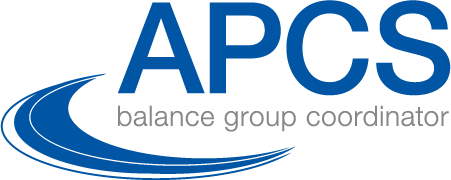Technical clearing
Periodic clearing and settlement process
Traders
Traders submit their schedules for the following day (in ESS format) by 2:30 p.m. on working days. On the last working day before weekends and public holidays, schedules including the following working day must be submitted by 2:30 p.m.
If formatted correctly, the schedules are automatically imported into the APCS system and can be viewed within a few hours in the access protected area of the APCS website (under the relevant components).
In the event of errors or corrections, schedules can also be sent subsequently; the schedule with the highest version number is the valid one.
The latest possible date for correcting schedules is the 10th working day of the following month (last day of the data delivery period). The latest date for correcting schedules is the 10th working day of the following month (last day of the data delivery deadline).
The external schedules of the traders are reported to the control area manager daily by 2:30 p.m. The control area manager transfers the data required for APCS the following day.
Once a day, APCS initiates the calculation of the balance sheet. Shortly thereafter, the reported and usable data is visible in the “Balancing” menu item in the clearing platform and can be checked by market participants.
Grid operators
Grid operators must submit the required data in accordance with the Other Market Rules and the T&C-BGC in MSCONS format to APCS within 8 working days after the first day of the respective month.
Correctly formatted data is automatically imported into the system and can be viewed within a few hours in the protected area of the APCS website (under the relevant components). Once a day, APCS initiates the calculation of the balance sheet. Shortly thereafter, the reported and usable data can be viewed in the “Balancing” menu item on the clearing platform and can be checked by market participants.
Errors are corrected by sending corrected data; the last email sent always overwrites the messages sent previously.
After the 8 working days for data delivery have expired, there is a 2-day data delivery period; here, a final correction is possible before the monthly clearing calculation begins.
On the 11th working day, APCS starts the settlement of the first clearing, which can take several hours. Once the plausibility of the result has been checked, the data is forwarded to Oesterreichische Kontrollbank AG (OeKB) for invoicing. OeKB immediately begins preparing and checking the invoices and sends them by email, if possible, on the same day to balance group representatives and grid operators with self-managed grid loss balance groups.
The invoice amounts will be debited from or credited to the accounts of the balance group representatives within three working days.
BGRs and grid operators have 14 days from the date of invoicing to raise objections to the invoices issued or to request a subsequent charging. For further details, please refer to the T&C-BGC and the associated annexes.
technical Clearing
Subsequent charging process
The subsequent charging can only be requested by a BGR or a grid operator. The requesting market participant will also receive the invoice for the costs incurred without exception. The relevant application form is provided here; it must be completed in full and sent by post to APCS.
If balance group aggregates, grid transfers, or schedules have not been transmitted or have been transmitted incorrectly, the corrected data can be transmitted and a subsequent charge requested.
Before corrected data can be submitted to APCS for subsequent charging, the submitter must contact the balance groups and suppliers concerned, including those who handle grid losses and own consumption in the grid concerned.
The data can be transmitted to APCS at any time after the request for subsequent charging has been submitted to APCS and the market participants concerned have been informed (see point 3), regardless of whether a date for subsequent charging has been set or not; the data will be “parked” until APCS carries out subsequent charging.
Furthermore, the data must be made available to the market participants concerned. It is important for the internal settlement of the market participants concerned to have the same data basis as APCS, as otherwise it is not possible to check the settlement.
Once the date for the subsequent charging has been determined, APCS will inform the market participants concerned by sending an email to the administrative and technical contact persons. Only the components listed in the subsequent charging request will be taken into account in the subsequent charging. The balance groups concerned will receive a new invoice showing the difference between the old and new invoices, which will be credited or debited to the account. In addition, the party who requested the subsequent charging will receive an invoice for the costs of the subsequent charging.
Technical clearing
Synthetic load profiles
Forecasting consumption values using load profiles
In order to determine the imbalance energy requirements of balance groups, actual consumption values determined by means of load profile meters are required.
However, due to the technical and organisational effort involved and the considerable costs associated with this, the installation of a load profile meter is not economically viable for small customers. This customer group is therefore assigned standardised load profiles. These load profiles serve as schedules for the supplier. The meter is read only once a year for small customers, and the second clearing is carried out 14 months after the first clearing on the basis of this meter reading.
Afterwards, each grid operator must transmit the relevant data generated in its grid to the balance group representatives and APCS, as this data is required to calculate the schedule deviations and the deviation from the load profile of each balance group.
Further information on the individual load profiles can be found in Chapter 6 of the Other Market Rules.
-
Load profiles 2029
-
Load profiles 2028
-
Load profiles 2027
-
Load profiles 2026
-
Load profiles 2025
-
Load profiles 2024
-
Load profiles 2023
-
Load profiles 2022
-
Load profiles 2021
-
Load profiles 2020
-
Load profiles 2019
-
Load profiles 2018
-
Load profiles 2017
-
Load profiles 2016
-
Load profiles 2015
-
Load profiles 2014
-
Load profiles 2013
-
Load profiles 2012
-
Load profiles 2011
-
Load profiles 2010
-
Load profiles 2009
-
Load profiles 2008
-
Load profiles 2007
-
Load profiles 2006
-
Load profiles 2005
-
Load profiles 2004




